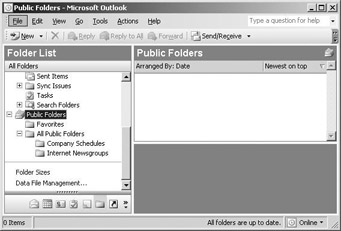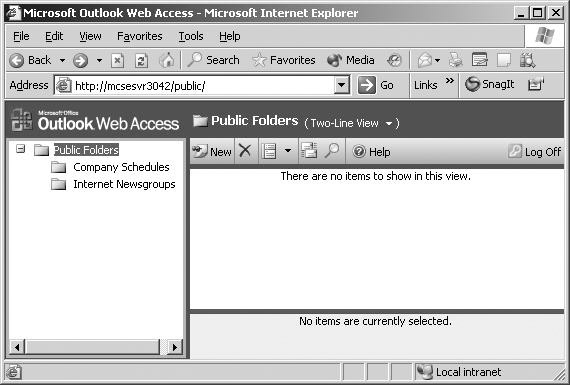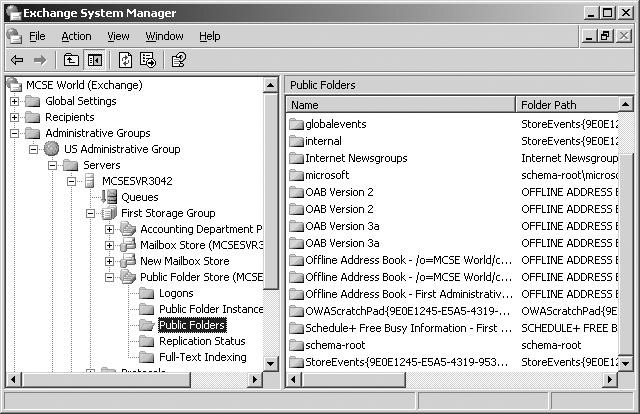![]() Chapter 5, “Creating and Managing Exchange Recipients,” covered the creation and management of three of the four basic types of recipients in Exchange Server 2003: users, groups, and contacts.
Chapter 5, “Creating and Managing Exchange Recipients,” covered the creation and management of three of the four basic types of recipients in Exchange Server 2003: users, groups, and contacts.
![]() This chapter explores the fourth type of recipient: public folders. Public folders are one of the most important objects in an Exchange environment. They are a key element in the creation of folder-based applications, such as bulletin boards, discussion groups, help desks, and many others. Public folders allow multiple users to share and collaborate on information. In this chapter, you will learn to do the following:
This chapter explores the fourth type of recipient: public folders. Public folders are one of the most important objects in an Exchange environment. They are a key element in the creation of folder-based applications, such as bulletin boards, discussion groups, help desks, and many others. Public folders allow multiple users to share and collaborate on information. In this chapter, you will learn to do the following:
-
 Create public folders
Create public folders -
 Configure public folders
Configure public folders -
 Use public folders
Use public folders -
 Manage public folders
Manage public folders
An Overview of Public Folders
![]() Public folders provide centralized storage for almost any type of information, including mail messages, electronic forms, documents from other applications, and even web pages.
Public folders provide centralized storage for almost any type of information, including mail messages, electronic forms, documents from other applications, and even web pages.
![]() Thus, public folders can be used to provide a number of advantages to your users:
Thus, public folders can be used to provide a number of advantages to your users:
-
 A public folder can serve as a forum where users can participate in threaded discussion forums with other users, similar to Internet newsgroups. In fact, public folders can even be used to provide your organization with access to Internet newsgroups.
A public folder can serve as a forum where users can participate in threaded discussion forums with other users, similar to Internet newsgroups. In fact, public folders can even be used to provide your organization with access to Internet newsgroups. -
 Public folders can provide a centralized storage area for documents for different groups or projects in your organization.
Public folders can provide a centralized storage area for documents for different groups or projects in your organization. -
 Public folders can store data for custom-designed workflow applications and, since public folders are exposed via Exchange’s Installable File System (IFS), they can store data for standard applications, as well.
Public folders can store data for custom-designed workflow applications and, since public folders are exposed via Exchange’s Installable File System (IFS), they can store data for standard applications, as well. -
 Public folders can store web pages that are delivered to browsers via the Internet Information Services.
Public folders can store web pages that are delivered to browsers via the Internet Information Services.
 Public Folder Configuration
Public Folder Configuration
![]() The configuration of public folders in Exchange Server 2003 happens in two places. Public folders can be created using either the Exchange System Manager or a MAPI client such as Office Outlook 2003. Exchange System Manager and Outlook are used in the following respects to manage public folders:
The configuration of public folders in Exchange Server 2003 happens in two places. Public folders can be created using either the Exchange System Manager or a MAPI client such as Office Outlook 2003. Exchange System Manager and Outlook are used in the following respects to manage public folders:
-
 Exchange System Manager is used to configure the public folder store of an Exchange server and server-related aspects of individual public folders.
Exchange System Manager is used to configure the public folder store of an Exchange server and server-related aspects of individual public folders. -
 Outlook is used to configure aspects of public folders such as permissions and electronic forms associated with the folders.
Outlook is used to configure aspects of public folders such as permissions and electronic forms associated with the folders.
![]() The reason why much of the public folder creation and management occurs in the Outlook client is that public folders are often used for workflow applications, and because most users work solely in the Outlook client, the administration of public folders was developed to reflect the application with which a user works.
The reason why much of the public folder creation and management occurs in the Outlook client is that public folders are often used for workflow applications, and because most users work solely in the Outlook client, the administration of public folders was developed to reflect the application with which a user works.
 Public Folder Storage
Public Folder Storage
![]() When you first install Exchange, a single public folder tree named All Public Folders is created. In previous versions of Exchange Server, an organization was stuck with only this default tree. In Exchange Server 2003, you can create multiple public folder trees that appear alongside the All Public Folders tree. Each public folder tree uses a separate database on an Exchange server.
When you first install Exchange, a single public folder tree named All Public Folders is created. In previous versions of Exchange Server, an organization was stuck with only this default tree. In Exchange Server 2003, you can create multiple public folder trees that appear alongside the All Public Folders tree. Each public folder tree uses a separate database on an Exchange server.
![]() While having multiple public folder trees sounds great, there is a catch: MAPI clients such as Outlook can access only the default public folder tree. The following types of clients can access the default public folder tree, but they are also the only ones that can access any additional trees that may have been created:
While having multiple public folder trees sounds great, there is a catch: MAPI clients such as Outlook can access only the default public folder tree. The following types of clients can access the default public folder tree, but they are also the only ones that can access any additional trees that may have been created:
-
 Applications such as Microsoft Word and Excel
Applications such as Microsoft Word and Excel -
 Web browsers
Web browsers -
 Windows Explorer
Windows Explorer -
 NNTP clients
NNTP clientsNote  The actual procedures for creating and using new public folder trees are covered later in this chapter.
The actual procedures for creating and using new public folder trees are covered later in this chapter.
![]() An Exchange organization can host multiple public folder trees. A public folder tree is organized hierarchically, like a directory structure (see Figure 6.1). The root, or highest level, of a tree is called the top level, and folders created here are called top-level folders. By default, all users may create folders at this level, but the Exchange System Manager console can be used to modify the list of users who have permissions to create top-level folders. It is important to have this administrative control so that users don’t clutter up the root of the tree and make it difficult to navigate.
An Exchange organization can host multiple public folder trees. A public folder tree is organized hierarchically, like a directory structure (see Figure 6.1). The root, or highest level, of a tree is called the top level, and folders created here are called top-level folders. By default, all users may create folders at this level, but the Exchange System Manager console can be used to modify the list of users who have permissions to create top-level folders. It is important to have this administrative control so that users don’t clutter up the root of the tree and make it difficult to navigate.
![]() All public folders are created in the public folder store of a particular Exchange server. Any Exchange server that has a public folder store can host a public folder. In a typical organization, some folders exist on one server, others on another server, and so on.
All public folders are created in the public folder store of a particular Exchange server. Any Exchange server that has a public folder store can host a public folder. In a typical organization, some folders exist on one server, others on another server, and so on.
![]() When a user creates a top-level public folder, it is placed in the Public Information Store on that user’s home server. When a user creates a lower-level public folder, it is placed in the Public Information Store of that new folder’s parent folder. In addition, each individual public folder can be replicated to other servers in the organization. As you can see, this situation could get complicated. Public folders in the same tree may exist on different servers, and some public folders have instances on multiple servers.
When a user creates a top-level public folder, it is placed in the Public Information Store on that user’s home server. When a user creates a lower-level public folder, it is placed in the Public Information Store of that new folder’s parent folder. In addition, each individual public folder can be replicated to other servers in the organization. As you can see, this situation could get complicated. Public folders in the same tree may exist on different servers, and some public folders have instances on multiple servers.
![]() A public folder is actually considered to have two parts. The first part is the public folder contents—the actual messages inside the public folder. The second part is that folder’s place in the public folder hierarchy. The contents of a public folder exist on a single server, unless you specifically configure the contents to be replicated to other servers.
A public folder is actually considered to have two parts. The first part is the public folder contents—the actual messages inside the public folder. The second part is that folder’s place in the public folder hierarchy. The contents of a public folder exist on a single server, unless you specifically configure the contents to be replicated to other servers.
![]() To ensure that information about public folders is distributed throughout the Exchange organization, Active Directory maintains a public folder hierarchy for each public folder tree, which is a single hierarchical structure that contains information about all the public folders in that tree. This hierarchy is automatically made available to every Exchange user in the organization.
To ensure that information about public folders is distributed throughout the Exchange organization, Active Directory maintains a public folder hierarchy for each public folder tree, which is a single hierarchical structure that contains information about all the public folders in that tree. This hierarchy is automatically made available to every Exchange user in the organization.
 Public Folder Web Access
Public Folder Web Access
![]() Exchange dynamically creates a URL for each item in the Information Store. This means that users can access any piece of Exchange information, including mailboxes, messages, and public folders, from a standard web browser. You can access the contents of any public folder using a simple address such as http://servername/public/foldername, as seen in Figure 6.2.
Exchange dynamically creates a URL for each item in the Information Store. This means that users can access any piece of Exchange information, including mailboxes, messages, and public folders, from a standard web browser. You can access the contents of any public folder using a simple address such as http://servername/public/foldername, as seen in Figure 6.2.
![]() Each public folder also has an HTML page associated with it. When you create a folder, Exchange automatically creates a default HTML page. You can replace the automatically generated web page with a custom page, or you can change the URL to point to another website. You can gain access to all of the contents in a folder by accessing the folder container or by accessing a dynamically generated URL. This functionality is provided by Internet Information Services, whose integration with Exchange is discussed in detail in Chapter 2, “Microsoft Exchange Architecture.”
Each public folder also has an HTML page associated with it. When you create a folder, Exchange automatically creates a default HTML page. You can replace the automatically generated web page with a custom page, or you can change the URL to point to another website. You can gain access to all of the contents in a folder by accessing the folder container or by accessing a dynamically generated URL. This functionality is provided by Internet Information Services, whose integration with Exchange is discussed in detail in Chapter 2, “Microsoft Exchange Architecture.”
 Public Folders and Active Directory
Public Folders and Active Directory
![]() Every public folder in a public folder store can appear as a mail recipient in the Global Address List. You can mail-enable a public folder by right-clicking it in Exchange System Manager, pointing to All Tasks, and selecting Mail Enable from the shortcut menu.
Every public folder in a public folder store can appear as a mail recipient in the Global Address List. You can mail-enable a public folder by right-clicking it in Exchange System Manager, pointing to All Tasks, and selecting Mail Enable from the shortcut menu.
![]() After a public folder is mail-enabled, the Exchange System Attendant service connects to Active Directory and creates an object for the public folder in a container named Microsoft Exchange System Objects in Active Directory Users and Computers.
After a public folder is mail-enabled, the Exchange System Attendant service connects to Active Directory and creates an object for the public folder in a container named Microsoft Exchange System Objects in Active Directory Users and Computers.
 System Folders
System Folders
![]() System folders are special public folders that are hidden by default and are accessible only through the System Manager snap-in (see Figure 6.3). You can view them by right-clicking the Public Folders container and selecting View Hidden Folders from the shortcut menu.
System folders are special public folders that are hidden by default and are accessible only through the System Manager snap-in (see Figure 6.3). You can view them by right-clicking the Public Folders container and selecting View Hidden Folders from the shortcut menu.
![]() System folders contain items that facilitate the capabilities of many Exchange clients, such as collaborative scheduling in Outlook. For the most part, you will want to leave these folders alone. Much of their functionality is configured through other areas in the System Manager. Nonetheless, it may be helpful to know what a few of the folders are used for:
System folders contain items that facilitate the capabilities of many Exchange clients, such as collaborative scheduling in Outlook. For the most part, you will want to leave these folders alone. Much of their functionality is configured through other areas in the System Manager. Nonetheless, it may be helpful to know what a few of the folders are used for:
-
 Offline Address Book (OAB) contains a subset of the Global Address List that remote users can download and use for addressing mail when they are not connected to the Exchange server.
Offline Address Book (OAB) contains a subset of the Global Address List that remote users can download and use for addressing mail when they are not connected to the Exchange server. -
 Schedule+ Free/Busy contains objects that support the scheduling capabilities of Exchange clients.
Schedule+ Free/Busy contains objects that support the scheduling capabilities of Exchange clients. -
 Schema-root contains objects related to the Active Directory Schema.
Schema-root contains objects related to the Active Directory Schema. -
 StoreEvents contains objects for the configuration of event information that specifically relates to the Information Store service.
StoreEvents contains objects for the configuration of event information that specifically relates to the Information Store service.







0 comments
Post a Comment